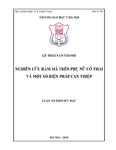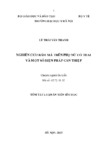
Please use this identifier to cite or link to this item:
http://dulieuso.hmu.edu.vn/handle/hmu/1669Full metadata record
| DC Field | Value | Language |
|---|---|---|
| dc.contributor.advisor | PGS.TS. Trần Lan, Anh | vi |
| dc.contributor.advisor | PGS.TS. Ngô Thị Kim, Phụng | vi |
| dc.contributor.author | Lê Thái Vân, Thanh | vi |
| dc.date.accessioned | 2021-11-14T13:35:41Z | - |
| dc.date.available | 2021-11-14T13:35:41Z | - |
| dc.identifier.uri | http://dulieuso.hmu.edu.vn//handle/hmu/1669 | - |
| dc.description.abstract | . THÔNG TIN TÓM TẮT NHỮNG KẾT LUẬN MỚI. CỦA LUẬN ÁN TIẾN SĨ. 1. Đặcđiểm lâm sàng và các yếu tố liên quan đến rám má. - Hơn 1/2 thai phụ bị rám má trong 3 tháng đầu, 99,8% thể cánh bướm; 76,7% rám má hỗn hợp; 90,2% có sạm da quầng vú; 59,6% có sạm da đường giữa bụng; 39,5% tàn nhang.. - Rámmá thường gặp ở thai phụ > 30 tuổi, mang thai 3 tháng cuối, đã từngsinh con; 32,8% có tiền sử rám má khi mang thai; 27,3% đã từng dùng thuốc tránh thai; 37,9% có tiền sử gia đình rám má; 39,5% tiếp xúc ánh nắng hơn 60 phút mỗi ngày; hầu hết không mang khẩu trang hoặc mangkhông đúng cách; 77,3% không có thói quen thoa kem chống nắng.. - Các yếu tố ảnh hưởng đến độ nặng của rám málà “không hiện diện tàn nhang”, “từ 30 tuổi trở lên”, và “tiếp xúc ánh nắng từ 9 -16 giờ hơn 60 phút mỗi ngày”.. 2. Nồng độ nội tiết tố estradiol, progesterone và mối liên quan với rám má. - Nồng độ estradiol và progesterone tăng cao trong thai kỳ nhưng không khác biệt giữa thai phụ có và không bị rám má. Nồng độ các nội tiết tố này không ảnh hưởng đến độ nặng của rám má xuất hiện trong thai kỳ.. - Thai phụ bị rám má có sạm da đường giữa bụng hoặc sạm da quầng vú thì khả năng có nồng độ estradiol hoặc progesterone tăng cao hơn gấp 3-5 lần so với thai phụ bị rám má không có các dấu hiệu này.. 3. Hiệu quả của một số biện pháp can thiệp. - Nhómbôiazelaic acid 20%cócảithiệnlâmsàngtăngdần, cảithiệnrõnhấttừsau 3 tháng can thiệp. Nhómbôikemchốngnắngcócảithiệnlâmsàngítthayđổi, cảithiệnnhẹlúctrướcsanh. Nhómmangkhẩutrangcórámmánặngdần.. - So sánhhiệuquảgiữacácnhóm: bôiazelaic acidhoặckemchốngnắngcótácdụngvượttrộihơnmangkhẩutrangtrongcảithiệnrámmá ở phụnữmangthai, khôngcósựkhácbiệtgiữahaiphươngthứcbôi can thiệp.. - Tácdụngphụ: đềunhẹvàbiếnmấtsau 4-5 tháng.. | vi |
| dc.description.abstract | Tóm tắt tiếng anh:. SUMMARY OF NEW CONCLUSIONS OF THE THESIS. 1. Clinical characteristics and melasma-related factors. - More than a half of pregnant women have melasma in the first trimester, malar pattern accounts for 99.8%; indeterminate type makes up 76,7%; 90.2% have darkening of the areola; 59.6% have darkening of the linear alba on the abdomen; 39.5% have freckles.. - Melasma is common in pregnant women over 30 years old, in the last trimester, given birth; 32.8% had a history of melasma when pregnant; 27.3% used oral contraceptives; 37.9% had family history of melasma; 39.5% exposed to sunlight more than 1 hour a day; most of them have not worn face mask or worn face mask improperly; 77.3% haven’t had a habit of using sunsreens.. - Factors affecting the severity of the disease are "no freckles”, "30 or older", "sunlight exposure 9am – 4pm more than 1 hour a day".. 2. Concentrations of estradiol, progesterone and relationship with melasma. - Estradiol, progesterone concentrations increase during pregnancy but did not differ between women with and without melasma. The concentrations of these hormones do not affect the severity of melasma that appear during pregnancy.. - In melasmic pregnant women with darkening of the linear alba on the abdomen or darkening of the areola, the concentrations of estradiol or progesterone is 3-5 times higher than those with melasma without these signs.. 3. The effectiveness of some interventional methods. - Azelaic acid group has clinical improvement incrementally, the most obvious improvement can be seen 3 months after the intervention. Sunscreen group has a slight clinical improvement, improved a little before giving birth. Melasma in Mask group aggravates.. - Comparing the effectiveness between the groups: treating melasma in Azelaic acid or Sunscreengroup have much better improvement than in Mask group in pregnant women. There is no difference between the two interventional methods.. - Side effects: mild and disappear after 4-5 months. | vi |
| dc.language.iso | vi | vi |
| dc.subject | 62720152 | vi |
| dc.subject | Da liễu | vi |
| dc.title | Nghiên cứu rám má trên phụ nữ có thai và một số biện pháp can thiệp | vi |
| dc.type | Thesis | vi |
| Appears in Collections: | Luận án (nghiên cứu sinh) | |
Files in This Item:
| File | Description | Size | Format | |
|---|---|---|---|---|
| 102_LA- Thanh DL(3).pdf Restricted Access | 61.29 MB | Adobe PDF |  Sign in to read | |
| 102_24- Than DL(1).pdf Restricted Access | 12.86 MB | Adobe PDF |  Sign in to read |
Items in DSpace are protected by copyright, with all rights reserved, unless otherwise indicated.